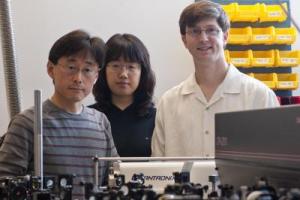Nov 26 2013
Spontaneous bursts of light from a solid block illuminate the unusual way interacting quantum particles behave when they are driven far from equilibrium. The discovery by Rice University scientists of a way to trigger these flashes may lead to new telecommunications equipment and other devices that transmit signals at picosecond speeds.
 Rice University researchers, from left, Junichiro Kono, Ji-Hee Kim and Timothy Noe discovered a way to extract superfluorescent bursts of light from solid-state materials without the need for a magnetic field. Their work appears in the journal Scientific Reports. Credit: Jeff Fitlow/Rice University
Rice University researchers, from left, Junichiro Kono, Ji-Hee Kim and Timothy Noe discovered a way to extract superfluorescent bursts of light from solid-state materials without the need for a magnetic field. Their work appears in the journal Scientific Reports. Credit: Jeff Fitlow/Rice University
The Rice University lab of Junichiro Kono found the flashes, which last trillionths of a second, change color as they pulse from within a solid-state block. The researchers said the phenomenon can be understood as a combination of two previously known many-body concepts: superfluorescence, as seen in atomic and molecular systems, and Fermi-edge singularities, a process known to occur in metals.
The team previously reported the first observation of superfluorescence in a solid-state system by strongly exciting semiconductor quantum wells in high magnetic fields. The new process – Fermi-edge superfluorescence – does not require them to use powerful magnets. That opens up the possibility of making compact semiconductor devices to produce picosecond pulses of light.
The results by Rice, Florida State University and Texas A&M University researchers were reported this month in Nature's online journal, Scientific Reports.
The semiconducting quantum wells at the center of the experiment contain particles – in this case, a dense collection of electrons and holes – and confine them to wiggle only within the two dimensions allowed by the tiny, stacked wells, where they are subject to strong Coulomb interactions.
Previous experiments by Rice and Florida State showed the ability to create superfluorescent bursts from a stack of quantum wells excited by a laser in extreme cold and under the influence of a strong magnetic field, both of which further quenched the electrons' motions and made an atom-like system. The basic features were essentially the same as those known for superfluorescence in atomic systems.
That was a first, but mysteries remained, especially in results obtained at low or zero magnetic fields. Kono said the team didn't understand at the time why the wavelength of the burst changed over its 100-picosecond span. Now they do. The team included co-lead authors Timothy Noe, a Rice postdoctoral researcher, and Ji-Hee Kim, a former Rice postdoctoral researcher and now a research professor at Sungkyunkwan University in the Republic of Korea.
In the new results, the researchers not only described the mechanism by which the light's wavelength evolves during the event (as a Fermi-edge singularity), but also managed to record it without having to travel to the National High Magnetic Field Laboratory at Florida State.
Kono said superfluorescence is a well-known many-body, or cooperative, phenomenon in atomic physics. Many-body theory gives physicists a way to understand how large numbers of interacting particles like molecules, atoms and electrons behave collectively. Superfluorescence is one example of how atoms under tight controls collaborate when triggered by an external source of energy. However, electrons and holes in semiconductors are charged particles, so they interact more strongly than atoms or molecules do.
The quantum well, as before, consisted of stacked blocks of an indium gallium arsenide compound separated by barriers of gallium arsenide. "It's a unique, solid-state environment where many-body effects completely dominate the dynamics of the system," Kono said.
"When a strong magnetic field is applied, electrons and holes are fully quantized – that is, constrained in their range of motion -- just like electrons in atoms," he said. "So the essential physics in the presence of a high magnetic field is quite similar to that in atomic gases. But as we decrease and eventually eliminate the magnetic field, we're entering a regime atomic physics cannot access, where continua of electronic states, or bands, exist."
The Kono team's goal was to keep the particles as dense as possible at liquid helium temperatures (about -450 degrees Fahrenheit) so that their quantum states were obvious, or "quantum degenerate," which happens when the so-called Fermi energy is much larger than the thermal energy. When pumped by a strong laser, these quantum degenerate particles gathered energy and released it as light at the Fermi edge: the energy level of the most energetic particles in the system. As the electrons and holes combined to release photons, the edge shifted to lower-energy particles and triggered more reactions until the sequence played out.
The researchers found the emitted light shifted toward the higher red wavelengths as the burst progressed.
"What's cool about this is that we have a material, we excite it with a 150-femtosecond pulse, wait for 100 picoseconds, and all of a sudden a picosecond pulse comes out. It's a long delay," Kono said. "This may lead to a new method for producing picosecond pulses from a solid. We saw something essentially the same previously, but it required high magnetic fields, so there was no practical application. But now the present work demonstrates that we don't need a magnet."